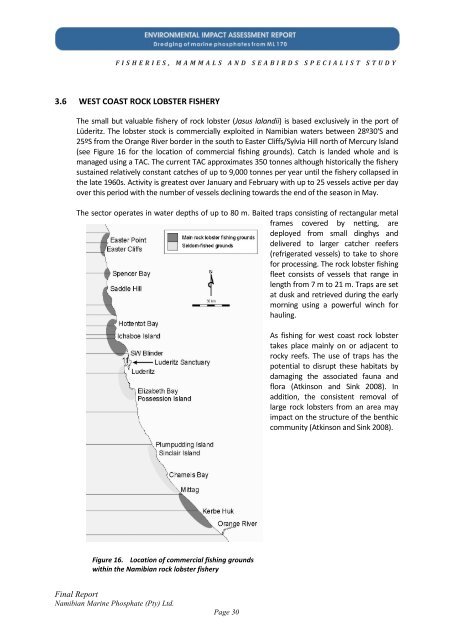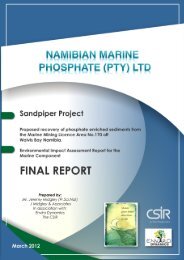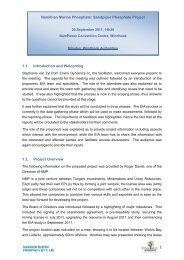Fisheries - Enviro Dynamics Namibia
Fisheries - Enviro Dynamics Namibia
Fisheries - Enviro Dynamics Namibia
Create successful ePaper yourself
Turn your PDF publications into a flip-book with our unique Google optimized e-Paper software.
F I S H E R I E S , M A M M A L S A N D S E A B I R D S S P E C I A L I S T S T U D Y<br />
3.6 WEST COAST ROCK LOBSTER FISHERY<br />
The small but valuable fishery of rock lobster (Jasus lalandii) is based exclusively in the port of<br />
Lüderitz. The lobster stock is commercially exploited in <strong>Namibia</strong>n waters between 28º30'S and<br />
25ºS from the Orange River border in the south to Easter Cliffs/Sylvia Hill north of Mercury Island<br />
(see Figure 16 for the location of commercial fishing grounds). Catch is landed whole and is<br />
managed using a TAC. The current TAC approximates 350 tonnes although historically the fishery<br />
sustained relatively constant catches of up to 9,000 tonnes per year until the fishery collapsed in<br />
the late 1960s. Activity is greatest over January and February with up to 25 vessels active per day<br />
over this period with the number of vessels declining towards the end of the season in May.<br />
The sector operates in water depths of up to 80 m. Baited traps consisting of rectangular metal<br />
frames covered by netting, are<br />
deployed from small dinghys and<br />
delivered to larger catcher reefers<br />
(refrigerated vessels) to take to shore<br />
for processing. The rock lobster fishing<br />
fleet consists of vessels that range in<br />
length from 7 m to 21 m. Traps are set<br />
at dusk and retrieved during the early<br />
morning using a powerful winch for<br />
hauling.<br />
Figure 16. Location of commercial fishing grounds<br />
within the <strong>Namibia</strong>n rock lobster fishery<br />
Final Report<br />
<strong>Namibia</strong>n Marine Phosphate (Pty) Ltd.<br />
Page 30<br />
As fishing for west coast rock lobster<br />
takes place mainly on or adjacent to<br />
rocky reefs. The use of traps has the<br />
potential to disrupt these habitats by<br />
damaging the associated fauna and<br />
flora (Atkinson and Sink 2008). In<br />
addition, the consistent removal of<br />
large rock lobsters from an area may<br />
impact on the structure of the benthic<br />
community (Atkinson and Sink 2008).

















